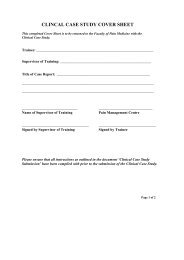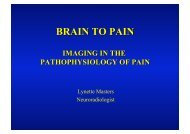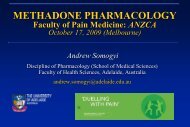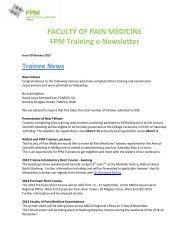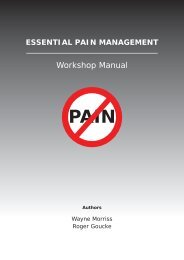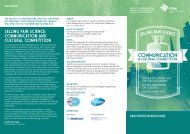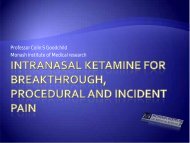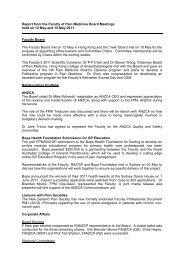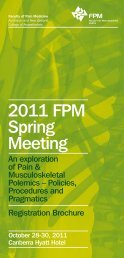Lecture 1 SOMOGYI.pdf - Faculty of pain medicine
Lecture 1 SOMOGYI.pdf - Faculty of pain medicine
Lecture 1 SOMOGYI.pdf - Faculty of pain medicine
You also want an ePaper? Increase the reach of your titles
YUMPU automatically turns print PDFs into web optimized ePapers that Google loves.
NON NEURONAL OPIOID ACTIONS<br />
<strong>Faculty</strong> <strong>of</strong> Pain Medicine: ANZCA<br />
October 16, 2009 (Melbourne)<br />
Andrew Somogyi and Mark Hutchinson<br />
Discipline <strong>of</strong> Pharmacology (School <strong>of</strong> Medical Sciences)<br />
<strong>Faculty</strong> <strong>of</strong> Health Sciences, Adelaide, Australia<br />
andrew.somogyi@adelaide.edu.au
Background: Opioids<br />
• Major drug class for moderate-severe<br />
– Acute <strong>pain</strong><br />
– Malignant <strong>pain</strong><br />
• Increased use in nonmalignant persistent <strong>pain</strong><br />
• Maintenance treatment for opioid-dependence<br />
– Methadone<br />
– Buprenorphine
Overview: Opioids<br />
• About 30 opioids marketed worldwide<br />
• 2007 Worldwide Consumption<br />
– Codeine 220 tons<br />
– Oxycodone 52 tons<br />
– Morphine 39 tons<br />
– Hydrocodone 38 tons<br />
– Methadone 28 tons<br />
– Pethidine 10 tons<br />
– Hydromorphone 2.2 tons<br />
– Fentanyl 1.3 tons<br />
International Narcotic Control<br />
Board: Report 2008
Target Site: Mu Opioid Receptor (µOR)<br />
Neuronal cell<br />
Agonist Binding:<br />
transmembrane regions II,<br />
III(1 st EC loop),V; N-<br />
terminal domain affects<br />
affinity<br />
G i /G 0 , G s<br />
3 rd Cytoplasmic loop:<br />
Signal transduction,<br />
Desensitization &<br />
Downregulation<br />
• member <strong>of</strong> G-protein coupled 7 transmembrane spanning receptor<br />
group (GPCR)
Opioid Actions: Intracellular<br />
• G 0 : Presynaptically<br />
– Close Ca 2+ channels fi<br />
– fl transmitter release<br />
• Glutamate, Ach, NA, SP,<br />
5HT<br />
– Stops <strong>pain</strong> transmission<br />
• G i : Postsynaptically<br />
– Open K + channels fi<br />
DORSAL HORN<br />
– Hyperpolarize & inhibit<br />
neurones<br />
– Makes cell less excitable • descending & ascending inhibitory &<br />
stimulatory pathways
Once Receptor is Activated by Opioid<br />
• Transmission <strong>of</strong> <strong>pain</strong> impulse is reduced<br />
• Neuronal cell is no longer in a state <strong>of</strong><br />
excitability<br />
• Acute dosing
Mu Opioid Receptor Activation<br />
• Spinal & Supraspinal analgesia<br />
• Respiratory Depression<br />
• Sedation<br />
• Nausea & vomiting<br />
• Miosis<br />
• Euphoria
Opioids Undesirable Effects: Long Term<br />
• Constipation<br />
• Nausea and Vomiting<br />
• Dry Mouth<br />
• HPA Axis Suppression<br />
• Immune Systems Suppression<br />
• Dependence & Tolerance<br />
• Neurotoxicities:<br />
– Allodynia, myoclonus, cognitive failure/delirium, sweating<br />
– Hyperalgesia<br />
• Large variability between patients and between opioids<br />
– Opioid rotation seems to work - WHY?
Traditional View <strong>of</strong> Opioid<br />
Mechanism <strong>of</strong> Action<br />
µ<br />
µ<br />
• Is there a<br />
missing link!<br />
ANALGESIA
The CNS Opioid-Immune Story<br />
• Glia<br />
• Toll-like Receptors<br />
• Pro-inflammatory cytokines<br />
• The Duel
What are Glia?<br />
• Immune-like cells: brain & spinal cord<br />
• 90% <strong>of</strong> the cells in the brain<br />
• No longer considered structural support: passive “mortar”<br />
• Function: support neurons physically (connective tissue)/ metabolically<br />
– Take up & degrade glutamate & GABA for neuronal synthesis<br />
• Bi-directional communication between glia and neurons<br />
Microglia<br />
Astrocytes<br />
Oligodendrocytes
GLIA<br />
• Immunocompetent cells: respond to<br />
– Exogenous signal: stress, subclinical infections, drugs<br />
– Endogenous signal: lipopolysaccharide (LPS)<br />
• Are they important in drug response?<br />
– Analgesia: opioids<br />
– Reward & withdrawal: opioids, alcohol …..
Role <strong>of</strong> Glia in Pain Neuropathies<br />
• Damaged Neuron, Virus, Diabetes ….<br />
Neuron<br />
Glia<br />
Inflammatory<br />
mediators<br />
Activation signal<br />
Pre synaptic<br />
modulation<br />
Neuronal<br />
Consequence =<br />
Pain<br />
• Neurons release “danger signal” molecules: Heat-shock proteins<br />
• Microglia mop-up molecules via toll-like receptors (TLR2, 4)- signalling<br />
• Constant TLR signalling fi fl (-ve) feedback fi proinflammatory cytokines (IL-1)<br />
• Prolonged proinflammatory <strong>pain</strong> response “allergy in dorsal horn spinal cord”
Opioids also Dysregulate Glia<br />
• Glia are activated<br />
• Proinflammatory response<br />
• Enhanced Pain - decreased analgesia<br />
• Increased tolerance, dependence, reward, etc<br />
Pain Neuron<br />
Inflammatory<br />
Mediators: IL-1 ..<br />
Gli<br />
a<br />
Opioid agonist<br />
Pre synaptic<br />
modulation<br />
Neuronal<br />
Consequence<br />
Dorsal horn glial activation from any source fi enhanced <strong>pain</strong>
Where is the Evidence?<br />
Minocycline: An Attenuator <strong>of</strong> Glial-<br />
Activation<br />
• Precise molecular mechanism(s) unknown<br />
• Not via TLR4
Minocycline Potentiates Morphine-Induced<br />
Analgesia in Rats<br />
• Activation <strong>of</strong> glia =› <strong>pain</strong> signals<br />
Hutchinson et al 2008, Brain Behav Immun 22: 1248-1256
Minocycline Attenuates Morphine-Induced<br />
Respiratory Depression in Rats<br />
•Activation <strong>of</strong> glia = disregulation <strong>of</strong> respiratory controls<br />
Hutchinson et al Brain Behav Immun 27, 1248, 2008
Minocycline Attenuates Morphine-Induced<br />
Reward in Rats<br />
• Activation <strong>of</strong> glia =› reward / dependence<br />
Hutchinson et al 2008, Brain Behav Immun 22: 1248-1256
Morphine + Minocycline<br />
Minocycline changes<br />
the Therapeutic Index<br />
<strong>of</strong> morphine from:<br />
Narrow<br />
to<br />
Wide<br />
In animals
What is the Target on Glia that Binds<br />
to Opioids to cause Activation?<br />
Link:<br />
• Naloxone (µ antagonist) can<br />
modify sepsis via LPS<br />
(lipopolysaccharide) activation<br />
• LPS- very strong glia-immune<br />
activator<br />
• LPS binds to TLRs
Glial Activation: Mechanism- TLRs<br />
Danger signals- Opioids<br />
TLRs
What are these TLRs?<br />
• Toll-Like Receptors<br />
– Family <strong>of</strong> pattern recognition receptors on Glia<br />
– TLR4 best known for being the endotoxin<br />
receptor<br />
– TLR4 & TLR2 are capable <strong>of</strong> recognising<br />
endogenous “danger signals”<br />
– Up regulated in neuropathic <strong>pain</strong><br />
– if expression is blocked <strong>pain</strong> does not develop
• Clinically<br />
used Opioids<br />
activate<br />
TLR4 with<br />
different<br />
“potencies”<br />
to µ receptor<br />
•(-)- morphine: mu active<br />
Hutchinson et al 2007
OPIOIDS: Mu Receptor Binding & TLR4<br />
Signal Activation: Different<br />
Mu Receptor<br />
Buprenorphine<br />
M6G<br />
Morphine, methadone<br />
Fentanyl<br />
Oxycodone<br />
Pethidine<br />
M3G<br />
(+)-naloxone/ (+)-naltrexone)<br />
TLR4 Signal<br />
M3G<br />
Oxycodone<br />
Fentanyl<br />
Pethidine<br />
methadone, morphine<br />
Buprenorphine<br />
M6G<br />
(+)-naloxone/ (+)-naltrexone)
Clinically Used Opioids activate TLR4<br />
• All 10 µM<br />
• opioid antagonists «<br />
• no stereoselectivity<br />
mOP active<br />
• M3G potent activator<br />
Hutchinson et al 2007
TLR4 Inactivation Increases Morphine<br />
Analgesia in TLR4 Knockout Mice<br />
• no TLR4 glial activation<br />
– fl <strong>pain</strong> signalling<br />
– 3x› analgesia with morphine<br />
Hutchinson et al 2009, Brain Behav Immun Epub Aug 14
TLR4 Selective Antagonist (LPS analog):<br />
decreases <strong>pain</strong> & increases opioid analgesia<br />
• Chronic constriction <strong>of</strong> rat sciatic nerve model<br />
Neuropathic <strong>pain</strong><br />
fl<br />
Opioid analgesia<br />
›<br />
Touch becomes <strong>pain</strong><br />
Hutchinson et al 2007
• All 10 µM<br />
mOP active<br />
Opioid<br />
Inactive<br />
Antagonists<br />
Isomers do<br />
not activate<br />
TLR4<br />
BUT<br />
Hutchinson et al 2007
Opioid Inactive Antagonists are<br />
TLR4 antagonists: (+)-naloxone<br />
• TLR4 signalling<br />
• Morphine analgesia<br />
Hutchinson et al 2007, 2009
Opioid Inactive Antagonists are<br />
TLR4 antagonists: (+)-naloxone (2)<br />
• Morphine Tolerance & Hyperalgesia are reduced<br />
Tolerance<br />
Hutchinson et al 2009 In Press
Opioid Analgesia: Cytokines<br />
• Opioids activate glia signalling to upregulate<br />
proinflammatory cytokines (IL-1ß) via TLR4 binding<br />
• Cytokines and analgesia/reward<br />
– Increase extracellular glutamate by down regulating<br />
glutamate transporter GLT-1 (most important mechanism)<br />
– phosphorylate NMDA receptor subunit -> increased activity<br />
– elevate dopamine release in NAc
Cytokines - Reward Mechanisms- Addictive Drugs<br />
Hyman et al Annu Rev Neurosci 29, 565, 2006
A Complicated Molecular Mechanism: TLR4<br />
Binding -> IL-1 release
Opioid-Induced Hyperalgesia (OIH)<br />
• Patients receiving opioids (to treat <strong>pain</strong>, addiction) may<br />
become more <strong>pain</strong> sensitive directly due to opioids<br />
• Double-edged sword!<br />
• Initial effects:<br />
– Analgesia, antihyperalgesia<br />
• Chronic effects:<br />
– Hyperalgesia<br />
– Tolerance
OIH in Methadone Maintenance<br />
Subjects: Response to Cold Pressor Pain<br />
Anticipated Response<br />
Actual Response<br />
150<br />
150<br />
Seconds<br />
100<br />
50<br />
Seconds<br />
100<br />
50<br />
0<br />
Placebo Trough Peak<br />
Control<br />
Methadone<br />
patients<br />
0<br />
Placebo Trough Peak<br />
Control<br />
(n=70)<br />
Methadone<br />
patients (n=34)<br />
Major disadvantage: cross sectional study
Chronic Nonmalignant Pain Patients show<br />
Hyperalgesic Responses to Cold Pressor Pain<br />
35<br />
30<br />
Seconds<br />
25<br />
20<br />
15<br />
10<br />
5<br />
0<br />
• Accumulating<br />
Evidence: Long term<br />
opioid exposure per se<br />
causes hyperalgesia<br />
Hay et al J Pain 10, 316, 2009
Opioid-Glial Interactions: Analgesic Tolerance<br />
Analgesia<br />
Morphine<br />
Expected<br />
Pain<br />
Tolerance<br />
Hyperalgesia<br />
IL-1 etc
Summary: Opioid-Glial Interactions<br />
• Opioids cause....<br />
– spinal glial activation via TLR4<br />
– › spinal proinflammatory cytokine (IL-1 ..) synthesis &<br />
release<br />
– Hyperalgesia, respiratory depression, tolerance<br />
• Blockade <strong>of</strong> opioid-induced glial activation fi<br />
– potentiates acute analgesia<br />
– fl respiratory depression<br />
– fl hyperalgesia, tolerance ….
Non Neuronal Opioid Actions<br />
• Activate Glia –signalling via TLR4<br />
• Proinflammatory response- IL-1 release<br />
• Enhanced Pain - decreased analgesia<br />
• Increased tolerance, dependence, reward, etc<br />
Pain Neuron<br />
Inflammatory<br />
Mediators: IL-1 ..<br />
Gli<br />
a<br />
Opioid agonist<br />
Pre synaptic<br />
modulation<br />
Neuronal<br />
Consequence:<br />
Hyperalgesia<br />
Tolerance<br />
….
Conclusion<br />
• Opioid efficacy & toxicity have a CNS immune<br />
signalling component<br />
• Potential for increasing the therapeutic<br />
window <strong>of</strong> opioids by decreasing adverse<br />
effects and increasing analgesia<br />
• Need clinical translation studies<br />
• Need newer & more selective TLR4 opioid<br />
binding site inhibitors
Acknowledgements<br />
• USA- Univ <strong>of</strong> Colorado (Linda Watkins Group)<br />
• NHMRC<br />
• National Institutes <strong>of</strong> Health (NIDA)<br />
• University <strong>of</strong> Adelaide<br />
• PhD student: Justin Hay, Liang Liu




